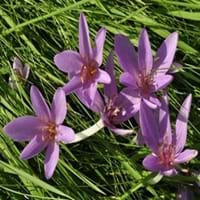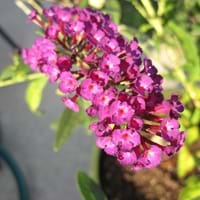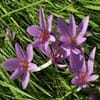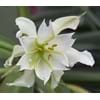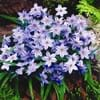Life Span
Perennial
Perennial
Type
Bulb or Corm or Tuber
Flowering Plants, Shrubs
Origin
Hybrid origin
Africa, America, Asia
Types
boissieri , cupanii , hungaricum , kesselringii
Lockinch, Petite Indigo, White Profusion
Habitat
Temperate Regions
Along Railroads, River side, Roadsides
USDA Hardiness Zone
Not Available
5-10
AHS Heat Zone
Not Available
9-2
Sunset Zone
21,22
H1, 2a, 2b, 3a, 3b, 4, 5, 6, 7, 8, 9, 10, 11, 12, 13, 14, 15, 16, 17, 18, 19, 20, 21, 22, 23, 24
Habit
Clump-Forming
Arching/Fountain-shaped
Flower Color
Purple, Violet
Blue, Pink, Purple, Red, White
Flower Color Modifier
Bicolor
Not Available
Fruit Color
Not Available
Not Available
Leaf Color in Spring
Green
Gray Green
Leaf Color in Summer
Light Green
Gray Green, Light Green
Leaf Color in Fall
Several shades of Green
Gray Green, Light Green, Yellow green
Leaf Color in Winter
Light Green
Not Available
Leaf Shape
Long Linear
Egg-shaped
Plant Season
Spring, Fall
Fall, Spring, Summer, Winter
Sunlight
Full Sun, Partial Sun
Full Sun, Part sun, Partial shade
Type of Soil
Loam
Loamy, Sandy, Well drained
The pH of Soil
Acidic, Neutral
Neutral, Slightly Acidic, Slightly Alkaline
Soil Drainage
Well drained
Well drained
Bloom Time
Late Summer, Early Fall
Spring
Tolerances
Drought
Drought, Pollution, Salt, Soil Compaction
Where to Plant?
Ground
Ground, Pot
How to Plant?
Divison, From bulbs, Seedlings
Seedlings, Stem Planting, Transplanting
Plant Maintenance
Medium
Medium
Watering Requirements
Keep ground moist
Form a Soil ring to water efficiently, Water Deeply, Water twice a day in the initial period
In Summer
Lots of watering
Lots of watering
In Spring
Moderate
Moderate
In Winter
Average Water
Average Water
Soil pH
Acidic, Neutral
Neutral, Slightly Acidic, Slightly Alkaline
Soil Type
Loam
Loamy, Sandy, Well drained
Soil Drainage Capacity
Well drained
Well drained
Sun Exposure
Full Sun, Partial Sun
Full Sun, Part sun, Partial shade
Pruning
no pruning required
Cut or pinch the stems, Prune for shortening long shoots, Prune if you want to improve plant shape, Prune ocassionally, Remove damaged leaves, Remove dead or diseased plant parts, Remove deadheads, Remove shoots
Fertilizers
All-Purpose Liquid Fertilizer
All-Purpose Liquid Fertilizer
Pests and Diseases
Dry root rot, Pest Free
Downy mildew, Leaf spot, Spider mites
Plant Tolerance
Drought
Drought
Flower Petal Number
Single
Single
Foliage Texture
Coarse
Medium
Foliage Sheen
Glossy
Matte
Attracts
Whiteflies
Butterflies, Hummingbirds
Allergy
Poisonous to grazing animals
Vomiting
Aesthetic Uses
along a porch, deck or patio, Borders, Mixed Border, small hedge
Showy Purposes
Beauty Benefits
No Beauty Benefits
Not Available
Environmental Uses
Air purification
Air purification
Medicinal Uses
anti rheumatic, cathartic
Not Available
Part of Plant Used
Root
Flowers, Leaves
Other Uses
Showy Purposes
Showy Purposes, Used as Ornamental plant
Used As Indoor Plant
No
No
Used As Outdoor Plant
Yes
Yes
Garden Design
Container, Cutflower, Foundation, Lawns and Turf, Mixed Border
Edging, Feature Plant, Foundation
Botanical Name
COLCHICUM 'Lilac Wonder'
Buddleia davidii
Common Name
Hybrid Autumn Crocus, Hybrid Meadow Saffron
Butterfly Bush, Summer Lilac, Butterflybush
In Hindi
meadow saffron
Butterfly Bush
In German
Herbstzeitlose
Schmetterlingsstrauch
In French
Colchique d'automne
buisson de papillon
In Spanish
Estado de conservación
arbusto de las mariposas
In Greek
meadow saffron
Butterfly Μπους
In Portuguese
Colchicum autumnale
arbusto de borboleta
In Polish
Colchicum autumnale
Butterfly Bush
In Latin
autumnale
papilio rubo
Phylum
Tracheophyta
Spermatophyta
Class
Magnoliopsida
Dicotyledonae
Family
Liliaceae
Scrophulariaceae
Clade
Angiosperms, Monocots
Angiosperms, Asterids, Eudicots
Tribe
Not Available
Not Available
Subfamily
Not Available
Not Available
Number of Species
Not Available
Season and Care of Meadow Saffron and Butterfly Bush
Season and care of Meadow Saffron and Butterfly Bush is important to know. While considering everything about Meadow Saffron and Butterfly Bush Care, growing season is an essential factor. Meadow Saffron season is Spring and Fall and Butterfly Bush season is Spring and Fall. The type of soil for Meadow Saffron is Loam and for Butterfly Bush is Loamy, Sandy, Well drained while the PH of soil for Meadow Saffron is Acidic, Neutral and for Butterfly Bush is Neutral, Slightly Acidic, Slightly Alkaline.
Meadow Saffron and Butterfly Bush Physical Information
Meadow Saffron and Butterfly Bush physical information is very important for comparison. Meadow Saffron height is 12.70 cm and width 20.30 cm whereas Butterfly Bush height is 7.50 cm and width 4.00 cm. The color specification of Meadow Saffron and Butterfly Bush are as follows:
Meadow Saffron flower color: Purple and Violet
Meadow Saffron leaf color: Green
Butterfly Bush flower color: Blue, Pink, Purple, Red and White
- Butterfly Bush leaf color: Gray Green
Care of Meadow Saffron and Butterfly Bush
Care of Meadow Saffron and Butterfly Bush include pruning, fertilizers, watering etc. Meadow Saffron pruning is done no pruning required and Butterfly Bush pruning is done Cut or pinch the stems, Prune for shortening long shoots, Prune if you want to improve plant shape, Prune ocassionally, Remove damaged leaves, Remove dead or diseased plant parts, Remove deadheads and Remove shoots. In summer Meadow Saffron needs Lots of watering and in winter, it needs Average Water. Whereas, in summer Butterfly Bush needs Lots of watering and in winter, it needs Average Water.
